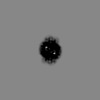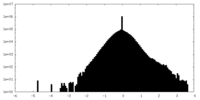+ Open data
Open data
- Basic information
Basic information
| Entry |  | |||||||||
|---|---|---|---|---|---|---|---|---|---|---|
| Title | Structure of RuBisCO from EMPIAR-10694 | |||||||||
 Map data Map data | ||||||||||
 Sample Sample |
| |||||||||
 Keywords Keywords | RuBisCO / tomography / PHOTOSYNTHESIS | |||||||||
| Biological species |  | |||||||||
| Method | subtomogram averaging / cryo EM / Resolution: 13.0 Å | |||||||||
 Authors Authors | Zhou Y / Huang QW / Bartesaghi A | |||||||||
| Funding support |  United States, 1 items United States, 1 items
| |||||||||
 Citation Citation |  Journal: Nat Methods / Year: 2024 Journal: Nat Methods / Year: 2024Title: MiLoPYP: self-supervised molecular pattern mining and particle localization in situ. Authors: Qinwen Huang / Ye Zhou / Alberto Bartesaghi /  Abstract: Cryo-electron tomography allows the routine visualization of cellular landscapes in three dimensions at nanometer-range resolutions. When combined with single-particle tomography, it is possible to ...Cryo-electron tomography allows the routine visualization of cellular landscapes in three dimensions at nanometer-range resolutions. When combined with single-particle tomography, it is possible to obtain near-atomic resolution structures of frequently occurring macromolecules within their native environment. Two outstanding challenges associated with cryo-electron tomography/single-particle tomography are the automatic identification and localization of proteins, tasks that are hindered by the molecular crowding inside cells, imaging distortions characteristic of cryo-electron tomography tomograms and the sheer size of tomographic datasets. Current methods suffer from low accuracy, demand extensive and time-consuming manual labeling or are limited to the detection of specific types of proteins. Here, we present MiLoPYP, a two-step dataset-specific contrastive learning-based framework that enables fast molecular pattern mining followed by accurate protein localization. MiLoPYP's ability to effectively detect and localize a wide range of targets including globular and tubular complexes as well as large membrane proteins, will contribute to streamline and broaden the applicability of high-resolution workflows for in situ structure determination. | |||||||||
| History |
|
- Structure visualization
Structure visualization
| Supplemental images |
|---|
- Downloads & links
Downloads & links
-EMDB archive
| Map data |  emd_45269.map.gz emd_45269.map.gz | 574.3 KB |  EMDB map data format EMDB map data format | |
|---|---|---|---|---|
| Header (meta data) |  emd-45269-v30.xml emd-45269-v30.xml emd-45269.xml emd-45269.xml | 11.4 KB 11.4 KB | Display Display |  EMDB header EMDB header |
| Images |  emd_45269.png emd_45269.png | 69.3 KB | ||
| Masks |  emd_45269_msk_1.map emd_45269_msk_1.map | 8 MB |  Mask map Mask map | |
| Filedesc metadata |  emd-45269.cif.gz emd-45269.cif.gz | 3.8 KB | ||
| Others |  emd_45269_half_map_1.map.gz emd_45269_half_map_1.map.gz emd_45269_half_map_2.map.gz emd_45269_half_map_2.map.gz | 4.2 MB 4.2 MB | ||
| Archive directory |  http://ftp.pdbj.org/pub/emdb/structures/EMD-45269 http://ftp.pdbj.org/pub/emdb/structures/EMD-45269 ftp://ftp.pdbj.org/pub/emdb/structures/EMD-45269 ftp://ftp.pdbj.org/pub/emdb/structures/EMD-45269 | HTTPS FTP |
-Validation report
| Summary document |  emd_45269_validation.pdf.gz emd_45269_validation.pdf.gz | 701.4 KB | Display |  EMDB validaton report EMDB validaton report |
|---|---|---|---|---|
| Full document |  emd_45269_full_validation.pdf.gz emd_45269_full_validation.pdf.gz | 700.9 KB | Display | |
| Data in XML |  emd_45269_validation.xml.gz emd_45269_validation.xml.gz | 8.7 KB | Display | |
| Data in CIF |  emd_45269_validation.cif.gz emd_45269_validation.cif.gz | 10.1 KB | Display | |
| Arichive directory |  https://ftp.pdbj.org/pub/emdb/validation_reports/EMD-45269 https://ftp.pdbj.org/pub/emdb/validation_reports/EMD-45269 ftp://ftp.pdbj.org/pub/emdb/validation_reports/EMD-45269 ftp://ftp.pdbj.org/pub/emdb/validation_reports/EMD-45269 | HTTPS FTP |
-Related structure data
- Links
Links
| EMDB pages |  EMDB (EBI/PDBe) / EMDB (EBI/PDBe) /  EMDataResource EMDataResource |
|---|
- Map
Map
| File |  Download / File: emd_45269.map.gz / Format: CCP4 / Size: 8 MB / Type: IMAGE STORED AS FLOATING POINT NUMBER (4 BYTES) Download / File: emd_45269.map.gz / Format: CCP4 / Size: 8 MB / Type: IMAGE STORED AS FLOATING POINT NUMBER (4 BYTES) | ||||||||||||||||||||||||||||||||||||
|---|---|---|---|---|---|---|---|---|---|---|---|---|---|---|---|---|---|---|---|---|---|---|---|---|---|---|---|---|---|---|---|---|---|---|---|---|---|
| Projections & slices | Image control
Images are generated by Spider. | ||||||||||||||||||||||||||||||||||||
| Voxel size | X=Y=Z: 3.42 Å | ||||||||||||||||||||||||||||||||||||
| Density |
| ||||||||||||||||||||||||||||||||||||
| Symmetry | Space group: 1 | ||||||||||||||||||||||||||||||||||||
| Details | EMDB XML:
|
-Supplemental data
-Mask #1
| File |  emd_45269_msk_1.map emd_45269_msk_1.map | ||||||||||||
|---|---|---|---|---|---|---|---|---|---|---|---|---|---|
| Projections & Slices |
| ||||||||||||
| Density Histograms |
-Half map: #1
| File | emd_45269_half_map_1.map | ||||||||||||
|---|---|---|---|---|---|---|---|---|---|---|---|---|---|
| Projections & Slices |
| ||||||||||||
| Density Histograms |
-Half map: #2
| File | emd_45269_half_map_2.map | ||||||||||||
|---|---|---|---|---|---|---|---|---|---|---|---|---|---|
| Projections & Slices |
| ||||||||||||
| Density Histograms |
- Sample components
Sample components
-Entire : Chlamydomonas reinhardtii
| Entire | Name:  |
|---|---|
| Components |
|
-Supramolecule #1: Chlamydomonas reinhardtii
| Supramolecule | Name: Chlamydomonas reinhardtii / type: cell / ID: 1 / Parent: 0 |
|---|---|
| Source (natural) | Organism:  |
-Experimental details
-Structure determination
| Method | cryo EM |
|---|---|
 Processing Processing | subtomogram averaging |
| Aggregation state | cell |
- Sample preparation
Sample preparation
| Buffer | pH: 7.4 |
|---|---|
| Vitrification | Cryogen name: ETHANE-PROPANE |
- Electron microscopy
Electron microscopy
| Microscope | FEI TITAN KRIOS |
|---|---|
| Image recording | Film or detector model: GATAN K2 SUMMIT (4k x 4k) / Average electron dose: 3.0 e/Å2 |
| Electron beam | Acceleration voltage: 300 kV / Electron source:  FIELD EMISSION GUN FIELD EMISSION GUN |
| Electron optics | Illumination mode: FLOOD BEAM / Imaging mode: BRIGHT FIELD / Nominal defocus max: 5.0 µm / Nominal defocus min: 4.0 µm |
| Experimental equipment |  Model: Titan Krios / Image courtesy: FEI Company |
- Image processing
Image processing
| Final reconstruction | Applied symmetry - Point group: D4 (2x4 fold dihedral) / Resolution.type: BY AUTHOR / Resolution: 13.0 Å / Resolution method: FSC 0.143 CUT-OFF / Number subtomograms used: 35352 |
|---|---|
| Extraction | Number tomograms: 1 / Number images used: 36345 |
| Final angle assignment | Type: MAXIMUM LIKELIHOOD |
 Movie
Movie Controller
Controller











 Z (Sec.)
Z (Sec.) Y (Row.)
Y (Row.) X (Col.)
X (Col.)












































